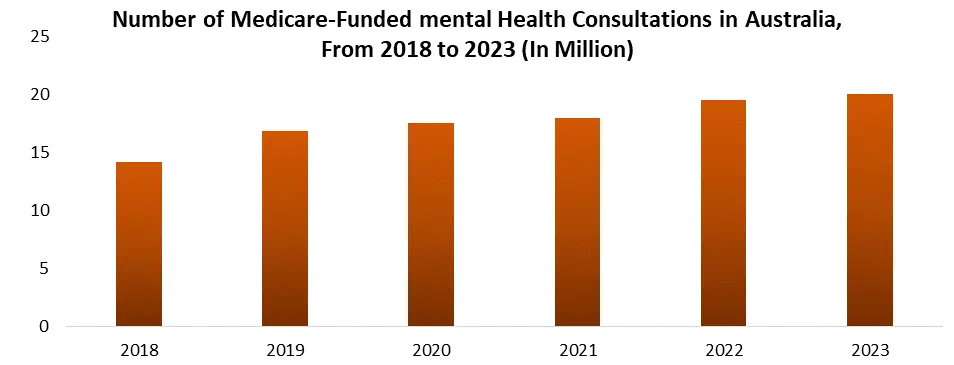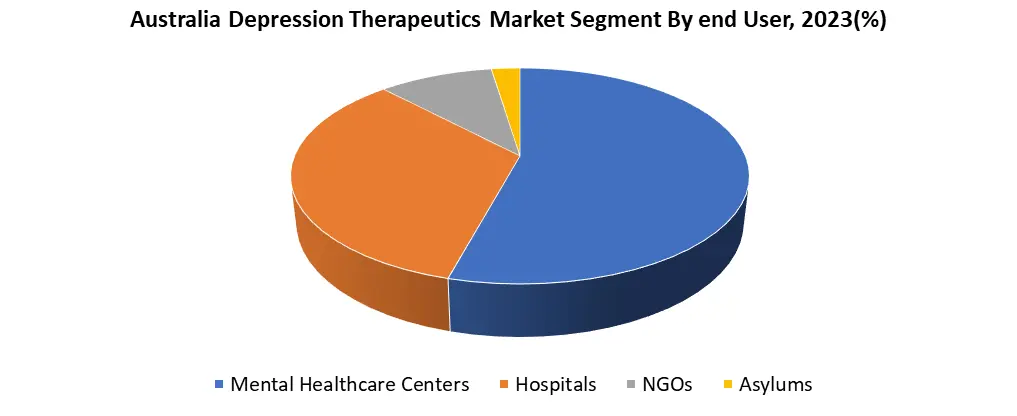The Australia Depression Therapeutics Market size was valued at USD 129 million in 2023. The total Australia Depression Therapeutics Market revenue is expected to grow at a CAGR of 6.8% from 2023 to 2030, reaching nearly USD 206 Million.Australia Depression Therapeutics Market
The Australia Depression Therapeutics industry analysis in the MMR research report explores key market sectors. It evaluates dominant trends, challenges, and opportunities, providing insights into market dynamics. The report explores treatment methods, market actors, and regulatory landscapes, providing stakeholders with a comprehensive perspective on the Australian depression therapeutics industry. Digital therapeutics is a promising market for businesses and investors, thanks to rising usage and government support for digital health efforts. Personalized medicine presents a dynamic healthcare landscape by providing opportunities for investment and innovation by enabling the creation of customized treatments based on an individual's genetic and biological variables. Australia is primarily dependent on imports from Switzerland, Germany, and the United States for its pharmaceutical needs for treating depression. On the other hand, the country's modest exports of drugs and mental health services mostly to its Pacific surrounding countries showcase the complicated worldwide market for depression treatments. Every year, over one million Australians are diagnosed with depression. The Australian government allocated 1.5 billion for Medicare-funded mental health services in the fiscal year 2022–2023. These numbers indicate the huge financial commitment made to supporting mental health services in the entire country as well as the substantial impact that depression has on public health.To know about the Research Methodology :- Request Free Sample Report Focus on Early Intervention The growing emphasis on early intervention for mental health, particularly depression, is significantly impacting the market in several ways. Reduced stigma and more awareness are the primary reasons for an evident rise in the demand for mental health services. The current cultural trend encourages early intervention, which has resulted in an increase in the demand for specialized psychotherapy, mental health tests, and widely used digital therapies. The present trend shows an excellent move in the direction of early intervention tools development and proactive mental health care. Early intervention in depression prevents its advancement, resulting in reduced medical expenses, increased efficiency, and enhanced well-being. As a result, there is a decrease in healthcare costs, a decrease in employee absenteeism, an increase in worker productivity, and a rise in personal well-being and social engagement.
Percentage of Australians aged 16 years and over affected by depressive disorders
Workforce Shortage in Mental Health The global scarcity of mental health specialists, which also affects Germany, is a serious issue that has an influence on people's lives and the healthcare system. There is a 2 million mental health worker shortfall worldwide, according to MMR Research. Estimates indicate that at least 6,000 more psychologists and psychiatrists are needed in Australia. People who have limited access to treatment sometimes end up depending too much on drugs to manage their depression, possibly ignoring alternative methods. Long wait times for publicly funded services push patients toward expensive private care, making it more difficult for them to afford necessary medical care.
Type of Disorder Percentage affected in previous 12 months Percentage affected at any time in their life Depression Episode 4.1% 12.2% Dysthymia 1.5% 1.10% Bipolar disorder 1.9% 2.8% Any depressive disorder 6.4% 15.4% 
Australia Depression Therapeutics Market Segment Analysis
By end-user, the Mental Healthcare segment accounts for an estimated 45% of the overall German Teleradiology market. The rise of telemedicine appointments expands access to care, particularly for individuals in remote areas or facing transportation difficulties. MHCs increasingly incorporate teletherapy into their service offerings. Digital tools and mental health apps are increasingly utilized within Mental health centers as adjunctive support. These tools can help with self-monitoring, symptom tracking, medication adherence, and access to evidence-based psychoeducational resources.
Australia Depression Therapeutics Market Scope: Inquiry Before Buying
Australia Depression Therapeutics Market Report Coverage Details Base Year: 2023 Forecast Period: 2024-2030 Historical Data: 2018 to 2023 Market Size in 2023: US $ 129 Mn. Forecast Period 2024 to 2030 CAGR: 6.8% Market Size in 2030: US $ 206 Mn. Segments Covered: by Drug Type Anxiolytics Noradrenergic Agents Atypical Antipsychotics Antidepressants Anticonvulsants by Therapies Psychotherapy Deep Brain Stimulation Transcranial Magnetic Stimulation Cranial electrotherapy stimulation (CES) Electroconvulsive Therapy (ECT) by Indication Major Depressive Disorder (MDD) Bipolar Disorder Postpartum Depression Premenstrual Dysphoric Disorder (PMDD) Dysthymic Disorder by End-User NGOs Asylums Hospitals Mental Healthcare Centers Key Players in the Australia Depression Therapeutics Market
1. Woke Pharmaceuticals 2. Rehydraid 3. Atherton Pharmaceuticals 4. Kira Biotech 5. Zucero Therapeutics 6. BrainsWay Ltd 7. Neuronetics, Inc 8. Pfizer 9. AstraZenecaFAQs:
1. What are the key strategies for successful market entry in Australia? Ans. Collaborating with established players, conducting thorough market research, and addressing specific patient needs are crucial for successful entry. Focusing on cost-effective therapies with demonstrably improved outcomes is expected to enhance market acceptance. 2. Which segments constitute the Depression Therapeutics in Australia? Ans. Drug type, Therapies, Indication, and End User. These are the segments constituted in Germany's ECG Equipment. 3. What is the projected market size & and growth rate of the Australia Depression Therapeutics Market? Ans. The Australia Depression Therapeutics Market size was valued at USD 129 Million in 2023. The total Australia Depression Therapeutics market revenue is expected to grow at a CAGR of 6.8% from 2024 to 2030, reaching nearly USD 206 Million By 2030.
1. Australia Depression Therapeutics Market Introduction 1.1. Study Assumption and Market Definition 1.2. Scope of the Study 1.3. Executive Summary 2. Australia Depression Therapeutics Market: Dynamics 2.1. Australia Depression Therapeutics Market Trends 2.2. PORTER’s Five Forces Analysis 2.3. PESTLE Analysis 2.4. Value Chain Analysis 2.5. Regulatory Landscape of Australia Depression Therapeutics Market 2.6. Technological Advancements in Australia Depression Therapeutics Market 2.7. Factors Driving the Growth of the Depression Therapeutics Market in Australia 2.8. Technological Advancements in Therapeutics 2.9. Government Policies Reform for the Healthcare Sector in Australia 2.10. Impact of Depression on society and community well-being in Australia 2.11. Successful Implementations in Depression Therapeutics in Australia 2.12. Prevalence of depression in Australia 2.13. Analysis of how depression therapeutics are integrated into the Australian healthcare system 2.14. Key Opinion Leader Analysis for Australia Depression Therapeutics Industry 2.15. Australia Depression Therapeutics Market Price Trend Analysis (2022-23) 3. Australia Depression Therapeutics Market: Market Size and Forecast by Segmentation for (by Value in USD Million) (2023-2030) 3.1. Australia Depression Therapeutics Market Size and Forecast, by Product (2023-2030) 3.1.1. Diagnostics devices 3.1.2. CO2 lasers 3.1.3. Hearing Aids 3.1.4. Image-Guided Surgery Systems 3.1.5. Others 3.2. Australia Depression Therapeutics Market Size and Forecast, by Surgical Device (2023-2030) 3.2.1. Powered Surgical Instruments 3.2.2. ENT Supplies 3.2.3. Ear Tubes 3.2.4. Handheld Instruments 3.2.5. Others 3.3. Australia Depression Therapeutics Market Size and Forecast, by Diagnostic Device (2023-2030) 3.3.1. Endoscopes 3.3.2. Hearing Screening Devices 3.4. Australia Depression Therapeutics Market Size and Forecast, by End Users (2023-2030) 3.4.1. Hospitals and Ambulatory Settings 3.4.2. ENT Clinics 3.4.3. Home Use 4. Australia Depression Therapeutics Market: Competitive Landscape 4.1. MMR Competition Matrix 4.2. Competitive Landscape 4.3. Key Players Benchmarking 4.3.1. Company Name 4.3.2. Product Segment 4.3.3. End-user Segment 4.3.4. Revenue (2023) 4.4. Market Analysis by Organized Players vs. Unorganized Players 4.4.1. Organized Players 4.4.2. Unorganized Players 4.5. Leading Australia Depression Therapeutics Market Companies, by market capitalization 4.6. Market Trends and Challenges in China 4.6.1. Technological Advancements 4.6.2. Affordability and Accessibility 4.6.3. Shortage of Skilled Professionals 4.7. Market Structure 4.7.1. Market Leaders 4.7.2. Market Followers 4.7.3. Emerging Players in the Market 4.7.4. Challenges 4.7.5. Mergers and Acquisitions Details 5. Company Profile: Key Players 5.1. Woke Pharmaceuticals 5.1.1. Company Overview 5.1.2. Business Portfolio 5.1.3. Financial Overview 5.1.4. SWOT Analysis 5.1.5. Strategic Analysis 5.1.6. Details on Partnership 5.1.7. Potential Impact of Emerging Technologies 5.1.8. Regulatory Accreditations and Certifications Received by Them 5.1.9. Strategies Adopted by Key Players 5.1.10. Recent Developments 5.2. Rehydraid 5.3. Atherton Pharmaceuticals 5.4. Kira Biotech 5.5. Zucero Therapeutics 5.6. BrainsWay Ltd 5.7. Neuronetics, Inc 5.8. Pfizer 5.9. AstraZeneca 6. Key Findings 7. Industry Recommendations 8. Australia Depression Therapeutics Market: Research Methodology